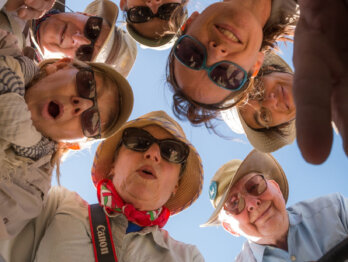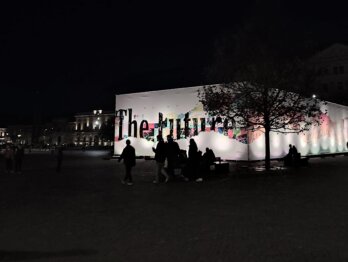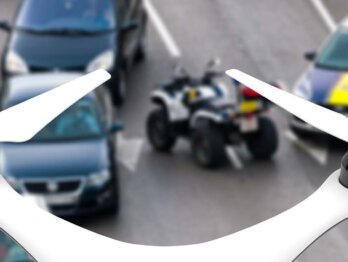Sensemaking possibilities #2: tools and analyses to support local and global sensemaking

Recently I posted about a sensemaking project to collect, curate, and provide tools to understand and contextualize the many ideas emerging from the COVID-19 crisis. Over the past months, there has been a deluge of articles taking the form “COVID-19 urgently proves the need for X,” where X is an investment, approach, program, policy, or complete paradigm shift. Which we think is a genuine and needed examination.
“William Hynes, Head of the New Approaches to Economic Challenges (NAEC) at the OECD, has remarked that if the 2008 Financial Crisis provided us with an x-ray of the fractures in our financial system, the Covid-19 pandemic is providing us with a three-dimensional CT (computerized tomography) scan that is revealing the systemic weaknesses of our societies.”
That first post triggered a range of submissions from the community. This follow up will serve as the beginning of series to report back those narratives, and to start thinking about what tools and analyses might support sensemaking: both at the local, contextualized level and the aggregated, global level.
We have a specific opportunity to both test and take advantage of a global, connected sensemaking activity in November through the Government After Shock event, but if the hypothesis behind this blog post holds up – that we have to keep testing and comparing the thinking that is emerging – then we’ll continue building out a suite of tools and connection points – more on this so what shortly. First, let us look at some example narratives.
Example narratives
We can start by looking at some of the themes that people submitted in response to the last blog post, and my starting example, with a short explainer for each:
- Doughnut economics: Instead of focusing on perpetual economic growth, the doughnut shape brings the concept of planetary boundaries together with the complementary concept of social boundaries, creating a safe and just space between the two, in which humanity can thrive.
- Degrowth: “What if, instead of going back to work full-time, we decided to work less, buy less, make less, and not fight to raise GDP at any cost?”
- Re-imagine democratic institutions to be more inclusive, participatory and deliberative: “Given the dangerous erosion of democracy in many places, a more holistic model of democracy is required which involves a combination of deliberative, participatory, direct and representative forms of democracy, where each may act to overcome the deficiencies of the other. Within this ‘vibrant democratic ecology’ there is an urgent need for participatory and deliberative democratic innovations that empower wider and deeper forms of citizen participation.”
- Radical rurality: “Rural areas can be places of opportunity, innovation, and diversification, if diverse notions of place can be reaffirmed in new and different ways through thoughtful approaches that recognize the right to the city, but also the right to multiple futures beyond the city limits.”
- Mission-oriented innovation: “Policymakers have the opportunity to determine the direction of growth by making strategic investments across many different sectors and nurturing new industrial landscapes, which the private sector can develop further, and as a result induce cross-sectoral learning and increase macroeconomic stability.”
- Systems thinking: Systems thinking offers an integrated perspective and a number of proven concepts, tools and methods to improve our understanding of the complex systemic issues which threaten the future. While “systems thinking” is a broad, umbrella term, it generally describes a methodology and a range of tools to disaggregate, understand and act on connected systemic issues – while taking proper account of the critical linkages between them.
Together, these narratives provide an initial set of concepts that the OPSI community has identified as meriting exploration. Within each category, it is possible to find an abundance of “COVID-19 urgently proves the need for X” suggestions and context specific recommendations. So what now?
First, I would like to acknowledge the limits of this exercise: each of the above concepts represents a complex, multi-faceted problem and solution space. Moreover, each has a community of experts, researchers, proponents, and detractors. Analytical, facilitation, and sensemaking tools abound, and can be fit-to-purpose for immediate needs. Layering a one-size-fits-all sensemaking framework over such a diverse set of fields creates only a thin analytical layer, not meant to replace deep study. What it does do, however, is start to create some connective tissue across time, space, ideas, and interest communities. More importantly, it provides a set of cases and examples of interest to people, which allows us to test analytical tools against real-world context.
Here I will skip ahead to the bigger why: the crisis has shaken our assumptions and challenged the status quo. It has highlighted that some well-entrenched parts of our systems are clearly not working – or are at least not the optimal solution. Governments are going through a rethinking process, but the approaches waiting in the wings are not, by default, better or complete. We have to test and compare the thinking that is emerging, and for that, we need to identify the different schools of thought through which alternatives are being generated.
We believe we can add value by providing a ‘light layer’ to serve as an initial sensemaking framework and tools for further exploration. If our hunch is correct, and we can identify and slightly redesign a core set of analytical and facilitation tools, it will enable people to do only conduct local, contextual analysis, but to aggregate and compare their analysis with a global community. It will allow many jurisdictions and public purpose organisations to build on each other’s work and benefit from the constellation of re-examining government that is happening right now.
At Government After Shock specifically, it will allow us to present aggregated insights back to the community in real time, frame high-level discussions in the voices from the edge, and fuel analysis and recommendations to be shared as reports in the follow-up.
The light layer
Out task is to start to add the light layer to these concepts, as a starting point before undertaking deeper exploration. For submissions, we asked for:
- a title
- a description
- a sense of whether the concept was more about policies, paradigms, behaviours, or methods
- a sense of the stage of lifecycle, from weak signal to maturity and closing gaps
- which sphere of public purpose it fit into (health, education, infrastructure, technology and data, economic development, international cooperation and development, social bonds and structures, environment, politics and governance)
Using this information, we have been able to map the narrative against the framework. Here, we use the narratives described above to demonstrate the approach.
Doughnut economics
Doughnut economics is a transformation, requiring changes to policies foremost and paradigms in support.
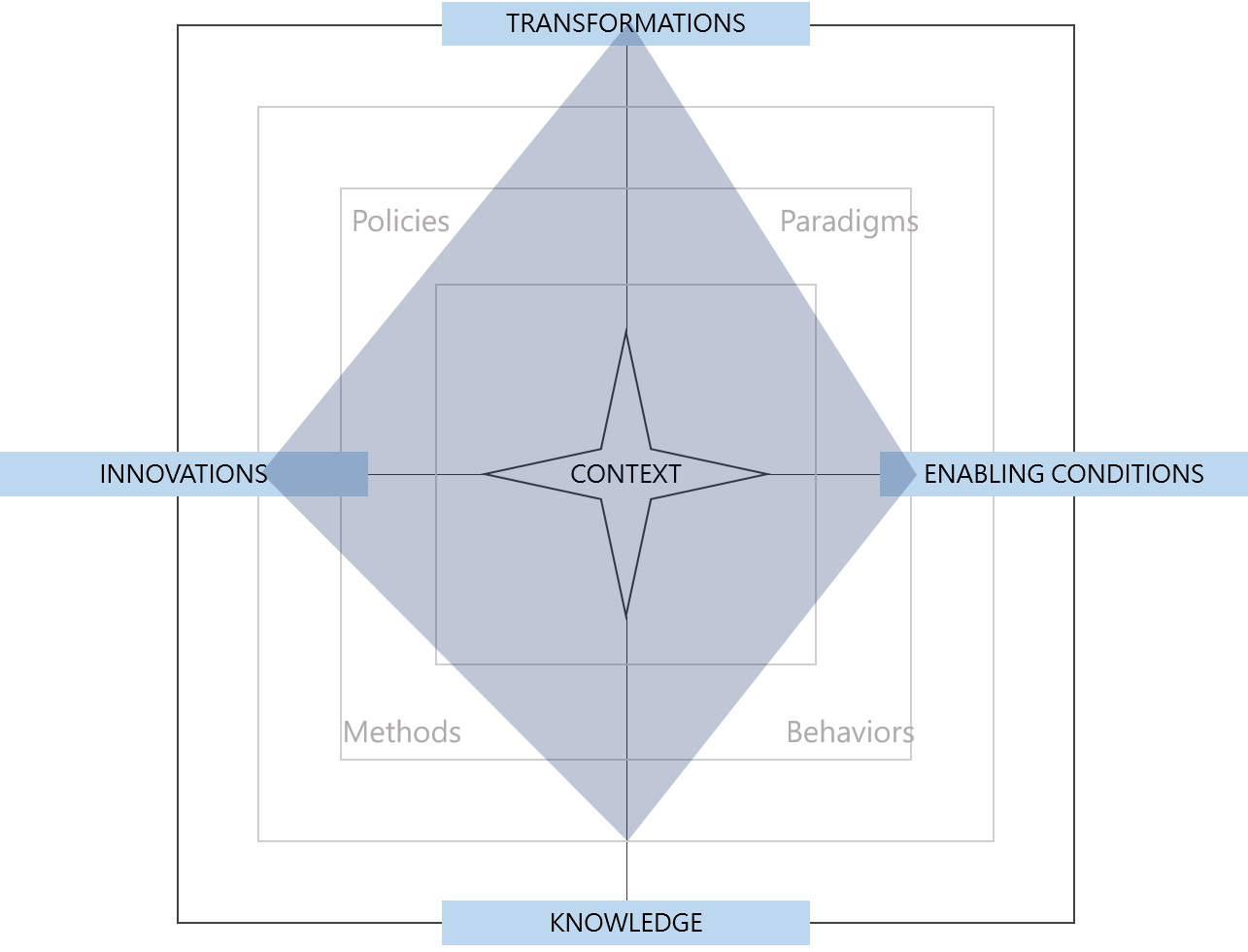
Degrowth
Degrowth is a transformation supported by new enabling conditions, which represents a paradigm shift.
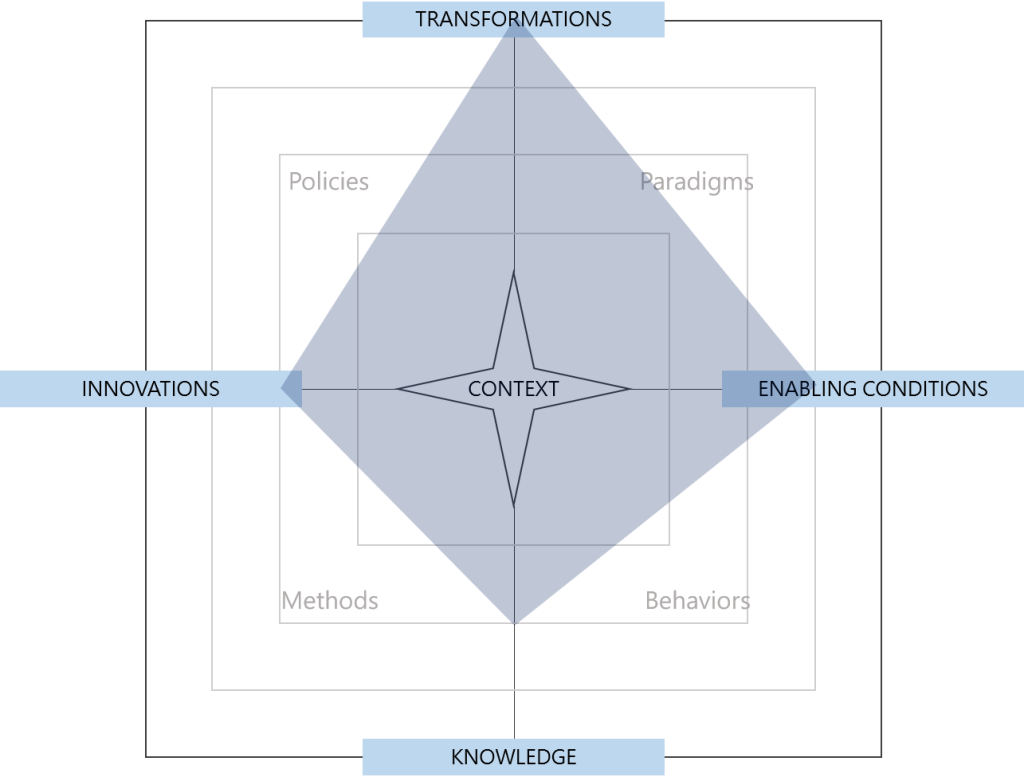
Re-imagine democratic institutions to be more inclusive, participatory and deliberative
To re-imagine democratic institutions, it requires both new enabling conditions and knowledge, meaning a focus on changed behaviours supported by shifts in paradigms and methods. Innovative methods of deliberative democracy are also involved, but are a means rather than an ends.
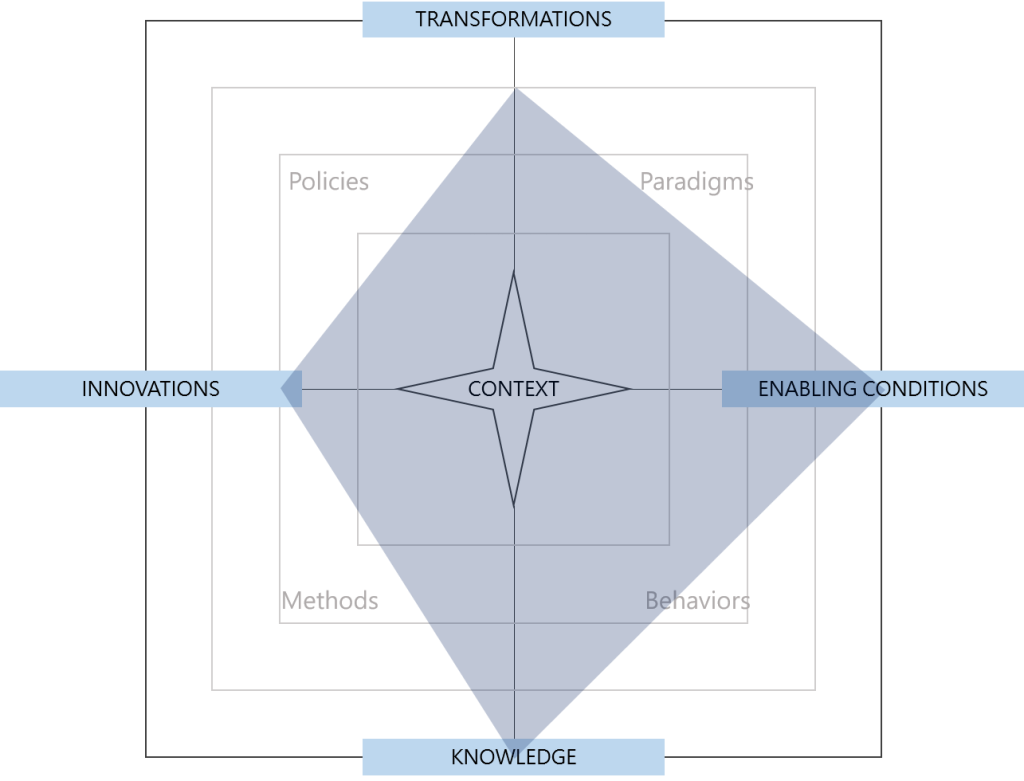
Radical rurality
Radical rurality follows the pattern of re-imagined democratic institutions: new enabling conditions and knowledge, meaning a focus on changed behaviours supported by shifts in paradigms and methods.
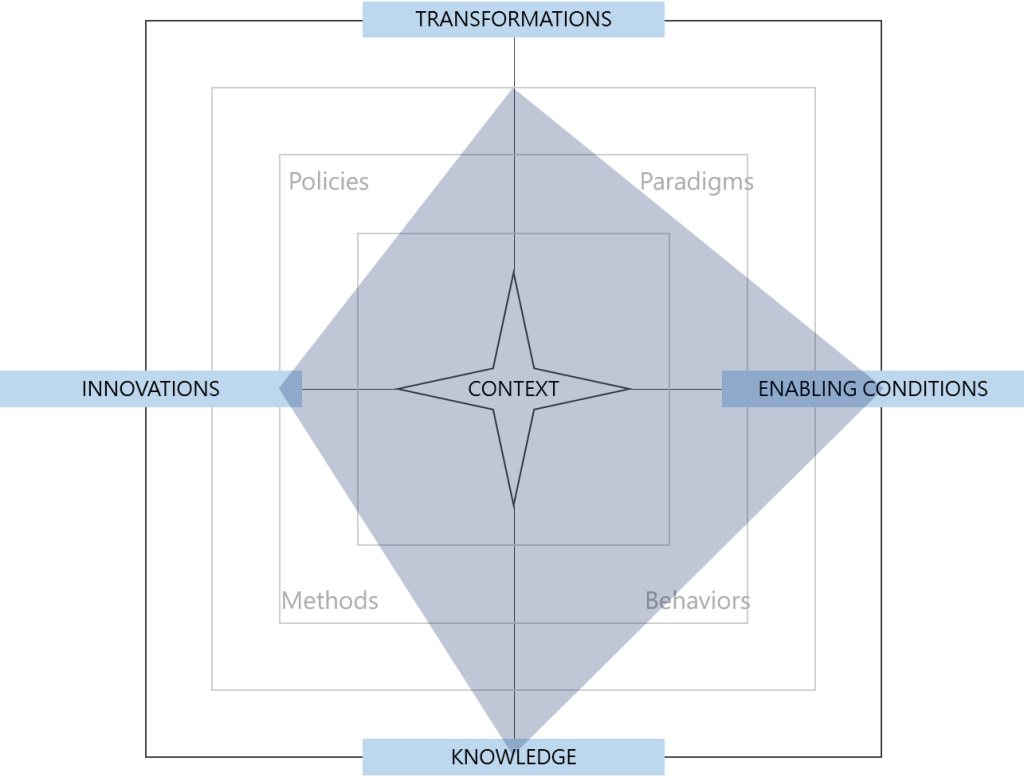
Mission-oriented innovation
Mission-oriented innovation is primarily an innovation activity, driven by supporting methods, and in some cases policies.
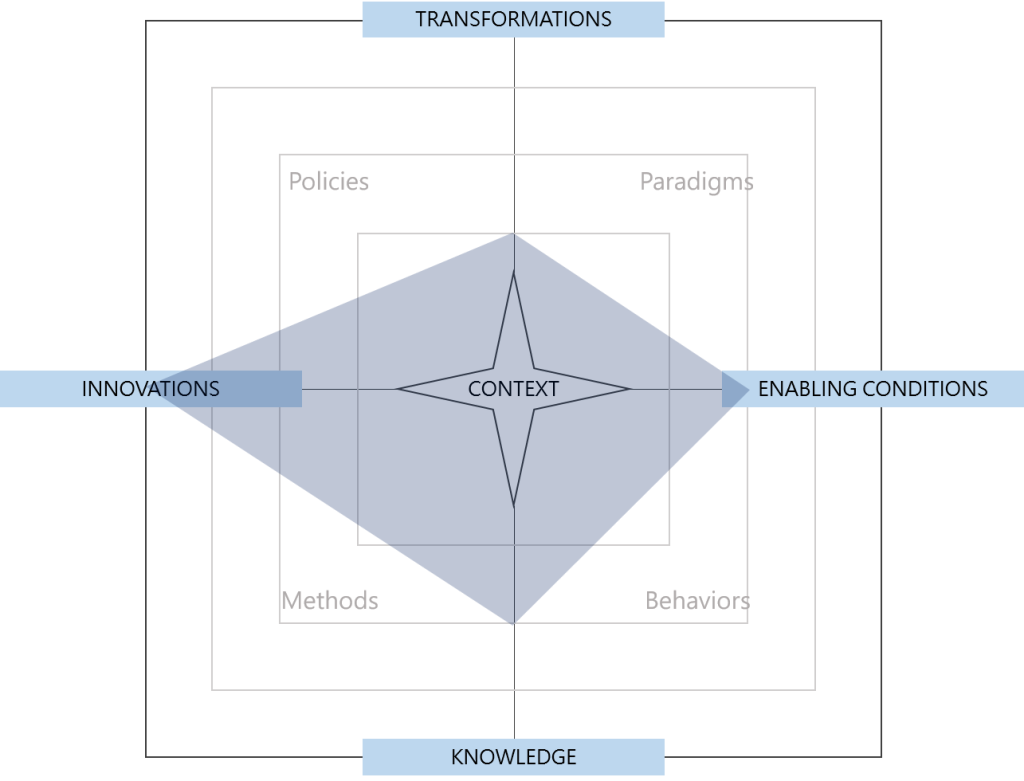
Systems thinking
Systems thinking is primarily about knowledge, and is driven by a methods focus supported by renewed behaviours.
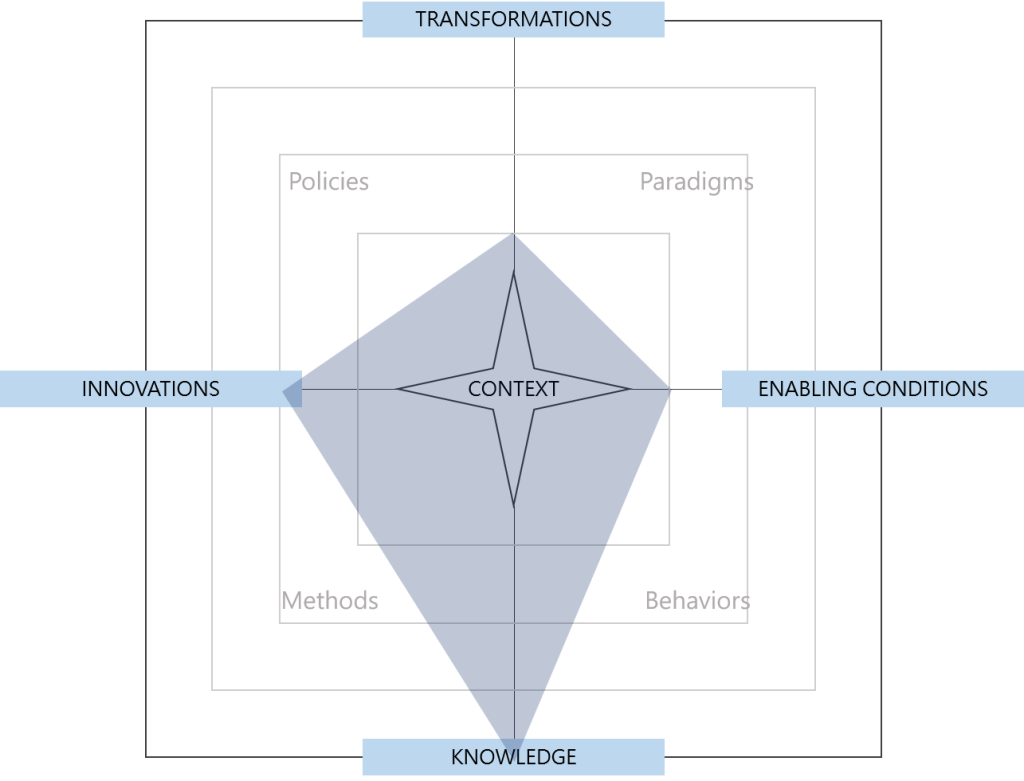
You get the idea. This is the first light layer: the mapping of narratives against a top-level framework. Again, let’s return to the so what:
First, when we look at competing narratives, we can start to assess what conceptual space they are in. Using our limited set of examples, if governments are hearing calls for degrowth and doughnut economics, they, while in many ways aligned, are competing paradigms. Systems thinking, however, seeks different conceptual space, requires different players, and may complement as much as compete.
Second, this can help people start to map their ‘theory of change’, the key stakeholders, participants, analytical needs, and outputs. Theory of change is particularly important here. At a high level, a common goal, such as greater sustainability and wellbeing, can become contested when theories of change or strategies for achieving the goal differ. A paradigm shift can lend itself to coalition building and ‘radical regime change’. In this context, the emphasis could be on adherence to new language and ideology or grassroots mobilisation to create a political window. Others might seek to influence policy windows through the involvement of policy makers, and may emphasise method innovation and gradual rather than radical transformation.
Lifecycle and sphere of public purpose
As a next step, we can map each narrative within a broad sphere of public purpose and also its lifecycle stage: from weak signals through to ideas that have reached maturity (where governments are optimising, focusing on inclusivity, or closing gaps). That map gets us to here, with areas of impact on the Y axis and maturity stages on the X axis:
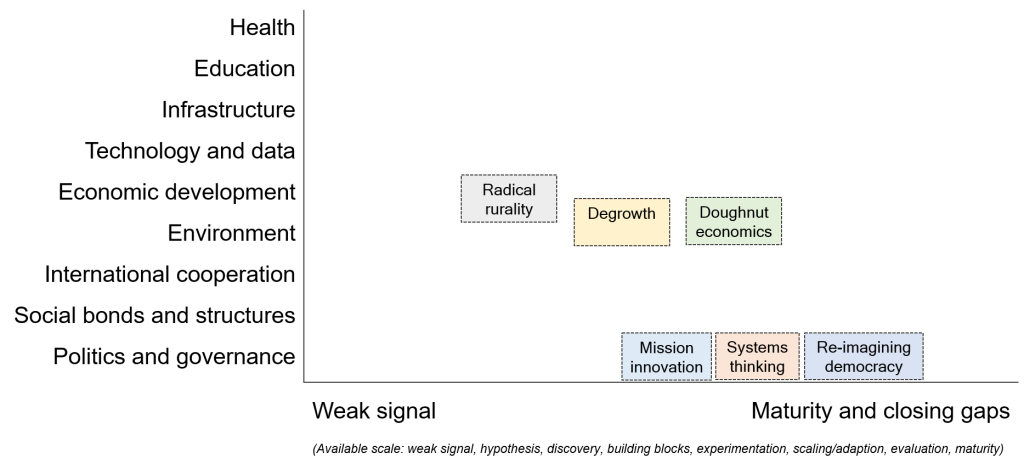
This quickly reveals that of our example set, three are in the blurry territory between economics and environment, and three are at the meta level of governance and organisation. This can help guide our discovery effort. We may need to keep looking for the narratives filling the other spaces. And as most of our examples are in the discovery or experimentation phases, we may want to look at both more and less mature ideas: the latter for how we could build on them or do them differently in this shifted governance landscape, and the former for potentially disruptive narratives that could emerge more strongly over time.
Analysis in local contexts
Of course, the above does not go deep enough. And as noted, there are many (many, many) analytical frameworks and tools (see our Toolkit Navigator). We are not just building these frameworks for ourselves, but for the wider community of facilitators that we hope will engage in this globally connected sensemaking activity – through the Government After Shock event in November but also through individual sensemaking explorations.
With this in mind, the question for facilitators is always one of maximizing the value of the time participants and stakeholders spend exploring and building insights together.
So if the above creates a light connective tissue, I want to ask: what specific tools and methods might help us go deeper? For instance, we can imagine a set of needs for governments, strategic policy shops, event convenors, and facilitators related to “future of government” narratives:
| Job to be done | Possible insights tool |
|---|---|
| Imagine how two different possible narratives would intersect and interact | Scenario analysis and mashup |
| Imagine how a narrative would fit into a local context | System mapping and comparison against change drivers |
| Imagine how to start a local dialogue around a narrative | Top partners and stakeholders / stakeholder mapping |
| Understand a narrative and find research and a range of views on it | Learning jam and reporting |
| Start stress testing a narrative and exposing problem areas | Red teaming / making space with Triz |
| Understand the mental models and worldviews behind something, including how others see it differently | Causal Layered Analysis |
| Gauge where the community thinks there’s most promise | Betting market collective analysis |
| Dig deeper into a topic around specific questions | Expert Q&A / Office Hours |
Again, here is the hunch for the so what: in isolation, it might be better for individual facilitators to choose a format tailored to their context, needs, and participants. However, if we can as a community identify a subset of solid core elements, there are three benefits:
- it saves people time in thinking through a tool that will serve a particular purpose, because we will have done it collectively
- it allows us to customize the design up front for our current context, which is simultaneously unique and universal as people around the world navigate the shock of Covid-19
- most importantly (by far), it allows us to design tools to aggregate towards global sharing and a global portrait of insights, creating connection points and substantial value for anyone exploring these sorts of questions, both in the immediate – during events – and in the longer term as knowledge mobilisation
Building from here
And while I welcome ideas, comments, and debate on everything about this blog post, this brings me to my second specific question: right now, we’re also collecting narratives and threads in a few ways:
- through these blog posts
- by watching what countries are doing
- by interviewing convenors and participants of other events that are looking at the future of governments and governance
- and seeing how people build Government After Shock network events
However, each of these methods draws on a particular community. We are starting to look at how we might use social network analysis, op-ed metrics, mass intelligence searches (e.g., Google Trends, LexisNexis) to get a baseline on what ideas are getting traction, and what people are thinking. I would love to hear methods and ideas.
That’s it. That’s the post.
I will follow up in a couple weeks with what we have heard, how the design work is progressing. And while much of the value of this work will come from local analysis in context, I’ll add more detail about what the aggregate could look like, both for real-time reporting back as well as what the OECD and OPSI can commit to for knowledge mobilization and driving towards a call to action for those looking at the future of government.
If there’s anything in the above that triggers your interest, or for which you’d like to better understanding our rationale, please let me know. The next blog will be a blend of what we are learning and more on the possibilities of what we can achieve together.

